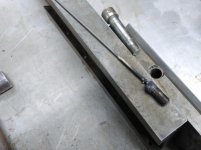Peter.
Titanium
- Joined
- Mar 28, 2007
- Location
- England UK
The cam bolt on my HLV was seized in solid and snapped when I tried to release it. It snapped right in the middle of the cam section which is approx. 2" in the hole leaving the thin end stuck fast in the small blind hole and half of the cam in the pull-stud which meant it had to come out somehow in order to dismantle the compound off the cross-slide. Looking at the end of the broken stud it was dirty over 2/3 the face so it looked like it was cracked for some time. Sure didn't take much to break it.
I tried drilling the stuck end so I could tap a thread for a slide-hammer - no joy there is was too hard for my HSS drill so I ground up a masonry bit and managed to drill in about 3/16" until the heat got into it and the end spun half a turn. This put the drill up against the side of the hole so I had to stop that. I was pleased that it had become un-frozen but it was still too tight to fall out even with loads of light tapping around the part with an aluminium drift.
In the end I used a trick I learned to get a broken hex key ball end out of a set screw one time. I got a TIG tungsten and put some shrink sleeving on it to prevent any arcing against the walls of the hole. I then used my TIG welder to fuse the end of the tungsten to the broken end by leaving just enough clearance to initiate the arc but close enough that it fused as soon as it struck. I had to wind the power up to 130amps before it would fuse with any strength but using a combination of this and light tapping on the pull-stud it finally came free and I got the broken end out with no damage to the casting or the pull-stud.


I tried drilling the stuck end so I could tap a thread for a slide-hammer - no joy there is was too hard for my HSS drill so I ground up a masonry bit and managed to drill in about 3/16" until the heat got into it and the end spun half a turn. This put the drill up against the side of the hole so I had to stop that. I was pleased that it had become un-frozen but it was still too tight to fall out even with loads of light tapping around the part with an aluminium drift.
In the end I used a trick I learned to get a broken hex key ball end out of a set screw one time. I got a TIG tungsten and put some shrink sleeving on it to prevent any arcing against the walls of the hole. I then used my TIG welder to fuse the end of the tungsten to the broken end by leaving just enough clearance to initiate the arc but close enough that it fused as soon as it struck. I had to wind the power up to 130amps before it would fuse with any strength but using a combination of this and light tapping on the pull-stud it finally came free and I got the broken end out with no damage to the casting or the pull-stud.




